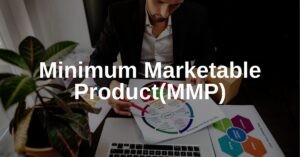Launching something new often starts with a guess, a prototype, or a half-built idea. Many teams rush to release a Minimum Viable Product, hoping to gather feedback and learn quickly. But when it’s time to go to market, you need more than feedback, you need something people will actually pay for.
In this guide, you’ll learn what a Minimum Marketable Product (MMP) is, how to build one that generates revenue, and how it can help you launch with purpose and profit.
What is Minimum Marketable Product?
A Minimum Marketable Product (MMP) is the smallest version of a product that delivers real value to a specific group of customers and is ready for sale. Unlike prototypes or internal tests, an MMP is built with the clear intention of generating revenue. It focuses on solving one key problem well enough that someone is willing to pay for it.
The goal of an MMP is not just to validate an idea, but to prove that people will exchange money for it. This approach helps teams avoid wasting months on features no one asked for. It’s a focused, fast-track path to finding product-market fit with actual customers.
How to Build a Minimum Marketable Product That Actually Sells
An MMP isn’t about stripping your product bare. It’s about creating the most compact version of your idea that customers will still happily pay for and talk about.
1. Identify a Niche Problem That Hurts Enough to Pay For
Before anything is built, you need to lock in a real problem, something painful, persistent, and clear enough that a specific group will want relief now. This isn’t just about creating a solution, it’s about solving a problem that people are willing to pay for.
Skip the vague problems that sound interesting but don’t generate urgency or potential for sales.
Talk directly to people, not personas. If your “ideal user” isn’t saying, “I’d buy this today,” you’re solving the wrong problem or for the wrong person.
Pro tip: Use direct outreach and lightweight landing pages with pre-sales to validate urgency and price tolerance before you write a single line of code.
2. Strip the Solution Down to the Core Outcome
Now that you know the problem, resist the urge to throw in every possible feature. Your job is to deliver just enough value to make the core outcome real and ready for sale. This means defining the smallest functional experience that not only solves the problem but also convinces users it’s worth paying for.
Don’t confuse minimal with incomplete. A good MMP feels finished in its purpose, even if it’s tiny. Every part should point directly at solving the specific problem you identified.
Pro tip: Build out a “must-have” list using real-user statements like “I need it to…” and cut anything that doesn’t directly support those goals.
3. Sketch and Validate Before You Code
Jumping into development without a visual walkthrough can waste time and effort. Use simple wireframes or clickable prototypes to confirm the flow, but also run pre-orders or gather interest from potential customers to see if they’re ready to pay for it. Even better, let real users react to your concept before writing backend logic.
People will often say “yes” to an idea in theory, then stall when it’s in front of them. A clickable prototype forces clarity. You’ll catch weak assumptions early, before they get expensive.
Pro tip: Use tools like Figma or Framer to fake the full experience visually and run pre-orders or signups against it.
4. Choose Tools That Speed You Up, Not Tie You Down
Tech choices matter, but only when they serve speed and clarity. Choose platforms and tools that let you build quickly, validate sales, and test real user interest with minimal infrastructure. Think no-code, low-code, or lightweight stacks, not over-engineered setups.
Founders often waste weeks obsessing over scale for a product that hasn’t sold once. You’re not building for scale yet, you’re building for proof. Start with flexibility, not future hypotheticals.
Pro tip: Start with platforms like Webflow, Bubble, or simple headless CMS setups to test fast without bottlenecks.
5. Set a Price and Ask for Payment Early
A Minimum Marketable Product is marketable because it’s sellable. Pricing too late leads to vague value propositions and soft validation. Pricing upfront forces you to define what the product is worth and lets you test if customers are actually willing to pay for it.
Don’t guess. Use price anchoring, early-bird offers, or transparent pre-sales to see what people will commit to. Sales are a stronger signal than signups or survey results.
Pro tip: Always test willingness to pay with a “buy” button, not a survey. The real metric is payment, not opinion.
6. Launch to a Small, Targeted Audience First
You don’t need a massive launch. You need a controlled, focused rollout to the exact people who would pay for this product. This group will help validate your pricing, market fit, and give you real feedback to refine the offer. Start narrow, learn fast, then grow.
Build an early-access list and keep your first 10–50 users close. Give them VIP access and use their feedback to sharpen your offer.
Pro tip: Treat your early adopters like co-creators, they’re your first testimonials and strongest promoters if you deliver well.
Real-World Minimum Marketable Products That Launched Right
Some of the most recognized tech brands started with a simple, focused product that solved one problem well. These early versions weren’t flashy, they were marketable, specific, and just enough to earn their first paying users.
Airbnb
Airbnb’s first version didn’t scale, didn’t include a sleek app, and didn’t cover global listings. It was a simple website to rent out space in one San Francisco apartment during a local conference.
It worked because it solved a clear, local problem: there were no affordable hotel rooms, and attendees needed a place to sleep. That one page generated paying guests, real feedback, and the confidence to keep building.
Dropbox
Before building a file-syncing engine, Dropbox launched with a two-minute explainer video targeted at early adopters on Hacker News. It didn’t require infrastructure or features, it showed the value clearly and collected thousands of emails from people who wanted in.
That validation proved people not only understood the product’s purpose, but wanted to use it. The video was their MMP because it got traction before code was shipped.
Buffer
Buffer didn’t launch with advanced analytics or multi-channel scheduling. It started with a single landing page explaining the concept and a button to sign up. When visitors clicked, they were taken to a second page showing pricing plans, which didn’t exist yet.
The team measured interest based on click-through rates, then followed up manually with early users to learn what mattered most.
Zappos
Before building warehouses or managing large inventories, Zappos tested demand by posting pictures of shoes from local stores. When someone ordered, the founder went to the store, bought the shoes, and mailed them himself.
That approach wasn’t scalable, but it proved people would buy shoes online if the experience felt trustworthy. It was scrappy, fast, and effective enough to validate the model.
Groupon
The first version of Groupon was built using WordPress, a PDF generator, and an email list. Deals were created manually and distributed through email with simple redemption instructions.
It worked because the team focused only on the core exchange: customers wanted local deals, and businesses wanted new foot traffic. They didn’t build tech until they had something people would pay for repeatedly.
Benefits of a Minimum Marketable Product (and the Trade-Offs to Watch For)
A Minimum Marketable Product isn’t just a leaner way to launch, it’s a smarter way to test real demand with less risk. Still, going lean doesn’t mean going easy, and there are trade-offs worth knowing before you dive in.
Advantages of Building a Minimum Marketable Product
1. Faster Time to Revenue
An MMP skips months of overbuilding and gets a usable product in front of paying customers sooner. You begin collecting revenue early, which can fund further development. It’s a practical way to stay lean without staying invisible.
2. Clearer Product-Market Fit Signals
Selling something forces sharper messaging and positioning. When people pay, you know you’re solving a problem they care about. That’s far more useful than collecting polite feedback on a prototype.
3. Reduced Risk of Feature Overload
Focusing only on what’s essential keeps the product clean and manageable. It’s easier to ship, test, and improve when the surface area is small. You avoid wasting effort on features users never needed.
4. Stronger Early Feedback Loops
Paying users tend to offer more thoughtful and honest feedback. Since they’ve already invested in the product, they’re more likely to share what’s missing or what should improve. This leads to better iteration cycles.
5. Builds Trust With Real-World Results
You’re not just showing mockups, you’re delivering value from day one. That builds credibility with users, investors, and potential partners. It proves you can execute, even on a limited budget.
Difficulties of Building a Minimum Marketable Product
1. Hard to Define “Minimum” Without Cutting Too Deep
Stripping a product down to the essentials can be tricky without undermining its usefulness. There’s a fine line between minimal and broken. Figuring out what truly needs to be there takes serious judgment.
2. Limited Room for Errors in UX
Since you’re shipping a tight version, every interaction counts. A clunky onboarding or confusing flow can kill the product before it has a chance to grow. Early users are less forgiving if something feels half-baked.
3. Early Customers May Expect More Than You Offer
People who pay expect results. If your product is still rough or missing features they assumed would be included, you risk disappointing them. That can lead to churn before you get a chance to improve.
4. Scaling Can Feel Like Starting Over
Once your MMP works, you often need to rebuild or restructure large parts of it for scale. Early decisions made for speed may not hold up under real growth. This can lead to technical or strategic debt.
5. Messaging Must Be Extremely Clear
You’re asking people to buy something simple, which means your value proposition needs to be airtight. Confusion leads to hesitation, and hesitation kills conversions. Getting your offer across clearly is just as important as building it well.
MMP vs. MVP: What’s the Difference and Why It Matters
A Minimum Viable Product (MVP) is designed to test core assumptions as quickly and cheaply as possible. It’s usually a stripped-down version of a product with just enough features to gather feedback from early adopters. The goal is to validate the idea and learn from real user behavior before committing to full development.
In contrast, a Minimum Marketable Product (MMP) is built with the intention of being sold. It includes only the features necessary to provide value, solve a clear problem, and generate revenue. While an MVP is about learning, an MMP is about delivering and proving market demand through actual sales.
This distinction is important because it reflects two different stages in a product’s lifecycle. MVPs help shape the right product direction, but MMPs test the product’s commercial potential. Knowing when to move from MVP to MMP can make or break your go-to-market strategy and affect how you scale.
Final Take: Build Small, Sell Smart, Learn Fast
A Minimum Marketable Product helps you stop guessing and start selling with purpose. It’s a focused way to ship value early without getting lost in endless development. By solving one clear problem well, you create real momentum and sharper insights. If you’re ready to launch lean, launch smart, and get paid while learning, this is your play.
Frequently Asked Questions
How do you know when your product is marketable enough to sell?
Your product is marketable when it delivers a clear solution to a real problem and someone is willing to pay for it. Pre-orders, pilot sales, or even direct messages expressing purchase interest are strong signs it’s time to launch.
Can a service-based business use a Minimum Marketable Product approach?
Yes, service-based businesses can apply the same principle by packaging a limited, outcome-driven offer. Instead of building software, you deliver a streamlined version of your service that solves one specific need and is easy to deliver repeatedly.
What metrics should you track with a Minimum Marketable Product?
Focus on metrics tied directly to value and behavior, such as conversion rate, retention, churn, and customer feedback quality. These will show if your product solves a problem well enough for people to keep using and paying for it.
Related:
- Breaking Into New Markets: The Ultimate Guide
- Starting Up a Business: 26 Lessons For New Entrepreneurs
- How to Pitch a Business Idea to an Investor: 7 Tips

We empower people to succeed through information and essential services. Do you need help with something? Contact Us.
Want a heads-up once a week whenever a new article drops?







